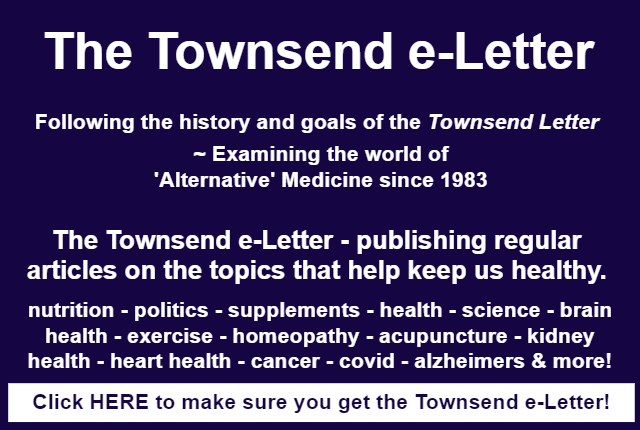Davis W. Lamson, MS, ND
Tahoma Clinic, Tukwila, WA
“Complementary oncology” refers to anything beyond the usual standard of care in mainstream oncology. That leaves a lot of room for various persuasions. Much of the public may not be aware of complementary oncology and its potential benefits.
The usual care includes surgery, chemotherapy, immunotherapy, and radiotherapy. These can all be useful therapies. Surgery has the highest rate of cure in oncology, if the cancer is found early, local, and entirely removed. However, that is a limited situation. All other uses of those four therapies constitute methods of life extension, with some remissions and fewer cures.
So mainstream oncology appears limited to refining a narrow framework of treatment that lacks the desired success rate. This seems short-sighted. Granted the problem of cancer is difficult, but to insist on continued use of a limited pharmaceutical framework that has not been more successful in curing cancer seems questionable. Naturally the lack of success spurred interest in non-pharmaceutical methods of treatment.
Why is the addition of complementary oncology desirable? The addition of many non-mainstream treatments for cancer are sensible and have shown beneficial results in humans. Such studies require finance that is seldom obtainable. Getting a complementary medical agent approved for use by the FDA is almost impossible considering the expense required. That amount would only be spent for a patentable product. Most complementary agents have been used for so long they are unpatentable. Thus, we have useful agents that are not patentable and will therefore never become part of mainstream medicine.
Medical treatment will become more and more high-tech, mostly a good thing. But with that comes higher expense and the percent of government funds spent on health care is already frighteningly high. That needs to be corrected and include useful non-patentable agents across all medical needs, not just oncology. Funds spent reliably evaluating complementary therapies could pay off in a reduced overall cost of health care.
The present writing is not about agents of treatment but is an overview of the objects in cancer care for which complementary medicine lends assistance. The first attempt by the writer to outline this was in 2007.1 Much information has accumulated since and has led to refinement of the title concept.
There are at least three major goals of complementary cancer care. The first is to realize that many with cancer are not in the best health and improving that could be a factor toward achieving remission. This seems largely ignored by standard oncology. It is an extensive subject and various aspects have been expounded on by many practitioners of complementary medicine.
The second goal is to improve the effectiveness of whatever standard therapy might be applied. In case that sounds presumptuous, take as one of many examples the multiple effects of the natural molecule piperine.2 Among anti-cancer attributes is the reversal of chemotherapy resistance. Why not apply it before resistance?
The third goal regards the state of remission; the definition being that no detectable cancer cells be detected for a month. Among those in remission, some are cured and don’t know it yet. Others will have a recurrence from undetectable remaining cancer cells or those genetically close.
Why not take steps to maintain the remission? The one case in mainstream oncology where this seems to be applied, but not named, is with estrogen receptor positive breast cancer. Application of an estrogen receptor blocker or an anti-aromatase limiting estrogen production after surgery has shown maintenance of remission and life extension. Why not do similarly for all cancers? We certainly know enough about the chemical pathways in cancer cells to apply sensible agents.
In 2017 an address was given at the national conference of the Oncology
Association of Naturopathic Physicians titled “Maintaining Remission and Connections of Toxic Metals to Cancer.”3 The presentation urged that remission was time to examine and remove all possible recognized oncogenic factors that could have fostered cancer in the first place, not to leave anything in place that could encourage recurrence.
These goals need to be lived up to. They require time, effort, and finance, but they are matters of life or death and that’s as serious as things get.
References
- Lamson, D.W. (2007) The Roles of Complementary Medicine in Oncology. Altern Med Rev 12(4):313-318.
- Lamson, DW. Piperine as Adjunct in Complementary Oncology. Townsend Letter Aug/Sept 2022.
- Lamson, DW. “Maintaining Remission and Connections of Toxic Metals to Cancer” National Conference of The Oncology Association of Naturopathic Phsicians, Phoenix, AZ. Feb 17, 2017.
Published March 11, 2023.
About the Author
Davis W. Lamson, MS, ND, received a naturopathic doctor degree from Bastyr University in 1982, and has been a staff physician at Tahoma Clinic. His original training was as a research chemist; and prior to practicing at Tahoma Clinic, he held positions in teaching and/or research at Iowa State University, Drexel University, and the University of Pennsylvania School of Medicine. He believes this initial training to be a major benefit in locating underlying causes of medical problems for his patients.



